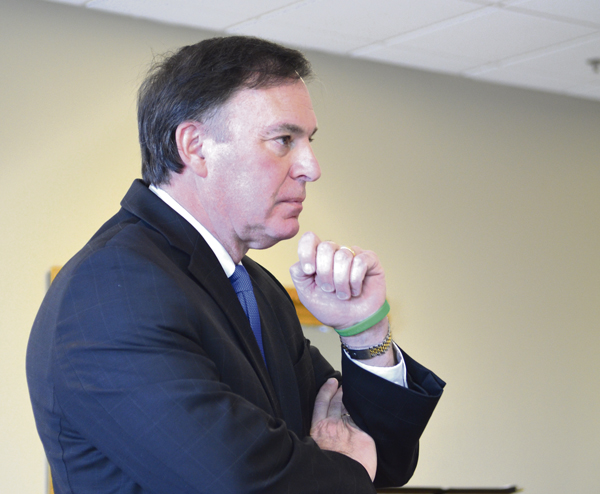
The conciliation report into the ongoing bargaining between the province and the Saskatchewan Teachers’ Federation (STF) shows that the two sides remain far apart on a key issue, but it has provided a possible way forward.
The report of the conciliation board was released Thursday. It outlines three key areas the teachers and the Ministry of Education remain opposed on — salary, class size and composition and substitute teacher contracts.
The conciliation board declared an impasse on Jan. 24.
Of those three issues, the conciliation board said class size and composition was “by far the most difficult.”
The province pointed out that the conciliator did not recommend that class size and composition be included in the collective bargaining agreement. However, the conciliator did not not recommend that class size and composition be included. Rather, it said that determination was outside of its mandate.
The provincial government is arguing that class size and composition are a local matter best left up to individual schools and school divisions. It also argued that classroom funding is “an education policy issue and a government fiscal responsibility … not a matter for collective bargaining.” It also argued that working condition s had been addressed locally through the use of preparation time in all school divisions.
The STF refutes the last point and argues that class size and composition are something that should be considered in the agreement because they amount to working conditions.
According to the report, they argue that the issue “is a matter of universal concern to Saskatchewan teachers and the legislation must be understood in the context of evolving social and economic realities. … It is clear in the teachers’ view that local boards do not have the resources to deal with these issues given recent changes that have eroded school board financial capacity.”
The teachers cite a Supreme Court ruling that collective bargaining is protected under the Canadian Charter of Rights and Freedoms.
The conciliation board said it wasn’t in a position to make a finding of a Charter violation, writing that it’s “up to the courts to settle such questions.
“It is not the role of the conciliation board to resolve this structural dispute” of what can be included within collective bargaining, the conciliator wrote.
Instead, the conciliator recommended that the STF, Saskatchewan School Boards Association (SSBA) and Minister of Education meet within the next four weeks to discuss possible solutions to the class size and composition issue.
Speaking to reporters Thursday, Education Minister Gord Wyant said he’s open to that possibility.
“I’ll be sending a letter today inviting the president of the STF and the president of the SSBA to meet with me to talk about this, pursuant to what the conciliators had to say,” he said.
“Hopefully we’ll be able to get together within the next couple of weeks (Legislative session) starts (in) march. I’m available at pretty much any time to have that meeting. The earlier we get together, the better.”
STF president Patrick Maze also said he’d be willing to have that conversation.
He said he is “absolutely” willing to have that conversation “assuming that the province recognizes that he would need to come to the table with the ability to bring further resources into classrooms and help students with more supports as opposed to just coming in saying ‘we’re going to study, we’ll form a committee.’”
Maze said the lack of supports in the classroom comes from a “chronic underfunding situation” that will be resolved by the government bringing more resources to the table.
While Wyant wouldn’t commit to increasing the availability of supports in the upcoming spring budget, according to the conciliation report, that may be on the horizon.
“There may be now funding for class size and composition initiatives announced in the upcoming spring budget,” the conciliation board wrote.
Wyant has put together a committee looking into the matter. The committee, he said, has met seven times and its recommendations are due soon. The STF has declined to sit on the committee, accusing Wyant of circumventing the bargaining process. Still, Wyant said, the invitation is open.
Wyant said the committee was formed because the province “realized that class size and composition was a significant issue in the classroom.
“I made no secret about the fact that’ it’s a challenge,” he said.
“The challenge really is how do we address it … not just through arbitration and through conciliation. Every classroom is different. Every school is different and every school division is different.”
Wyant said the issue of whether to negotiate class size and composition was rejected by the conciliation board.
“(In 2018) the arbitrator indicated that class size and composition had no place in the collective bargaining agreement. The conciliator has confirmed that,” he said.
Maze, though, has a different view.
“That’s absolutely false,” he said.
“They’re taking one piece of the recommendation of the fact that there wasn’t a strong recommendation saying it should be negotiated.”
Maze said the recommendation that the parties meet to discuss the issue was “fairy strongly—worded … recognizing the legitimacy of our concerns.”
Maze believes there are ways to negotiate class size and composition while still respecting local autonomy. He pointed to his organization’s proposed fund.
“There should be a strong, local voice in decisions made at the local level,” he said.
“It would be a local voice deciding what the local (school) needs, and then they could apply to this provincial fund in order to get resources out to students in their school division. There are ways to ensure that there’s a local voice and yet that is a provincial fix.”

